
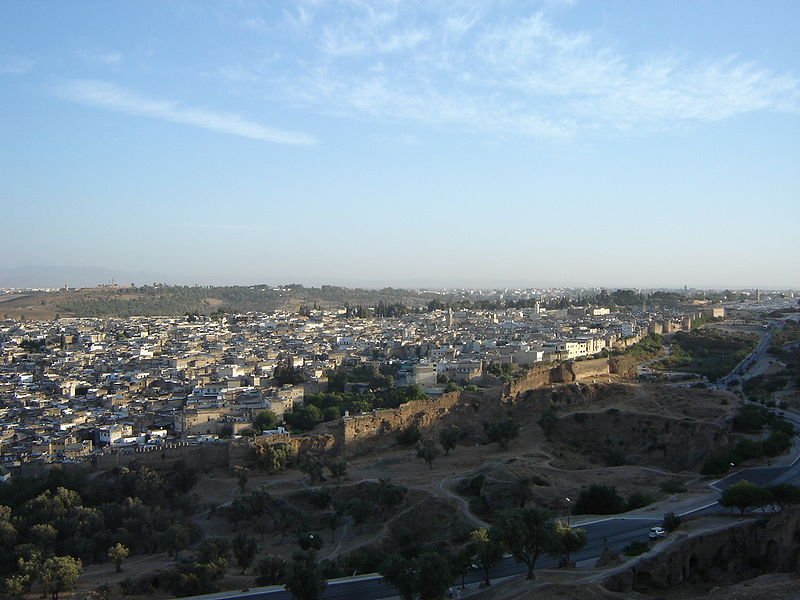 Old walled city of Fez, Morocco
Old walled city of Fez, Morocco http://commons.wikimedia.org/wiki/File:Fes_old_city.JPG
http://commons.wikimedia.org/wiki/File:Fes_old_city.JPG Patrick Morin
Patrick Morin
Fez (Arabic: فاس, French: Fès) is the second largest city of Morocco. The city of about a million people is also the capital of the Fès-Boulemane region. It is one of the four imperial cities of Morocco which includes Rabat, Marrakech and Meknes.
Fez has the oldest continuously functioning university in the world, the University of Al-Karaouine, which was founded in AD 859. Today Fez comprises two parts. The walled medieval part is called Fès el Bali. It is today a World Heritage Site. The newer part of town is called Fés el-Jedid. This is primarily a kasbah, or citadel, with the administrative buildings of the city.
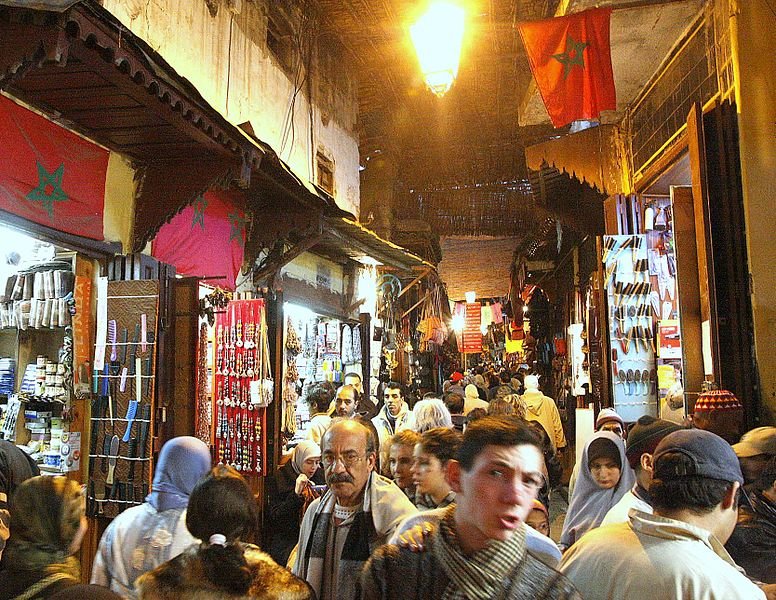 Medina of Fez
Medina of Fez http://commons.wikimedia.org/wiki/File:M%C3%A9dina_de_F%C3%A8s_%281%29.jpg
http://commons.wikimedia.org/wiki/File:M%C3%A9dina_de_F%C3%A8s_%281%29.jpg jfgornet
jfgornet
As with the other major cities of Morocco, Fez experiences a Mediterranean climate. The summers here are hot and dry while the winters are cool and wet. July and August get the highest temperature, with highs averaging 33°C (91°F). January temperature is the lowest, with lows averaging 6°C (43°F). February is the wettest month in Fez, receiving 102 mm (4 in ) of precipitation.
Fez is located on the inland part of northern Morocco, on the banks of the Fez river. It was established in AD 789 by Idris I, founder of the Zaydi Shite Idrisid Dynasty. In the 9th century, an influx of Arabs from Córdoba and Kairouan gave it its Arab character.
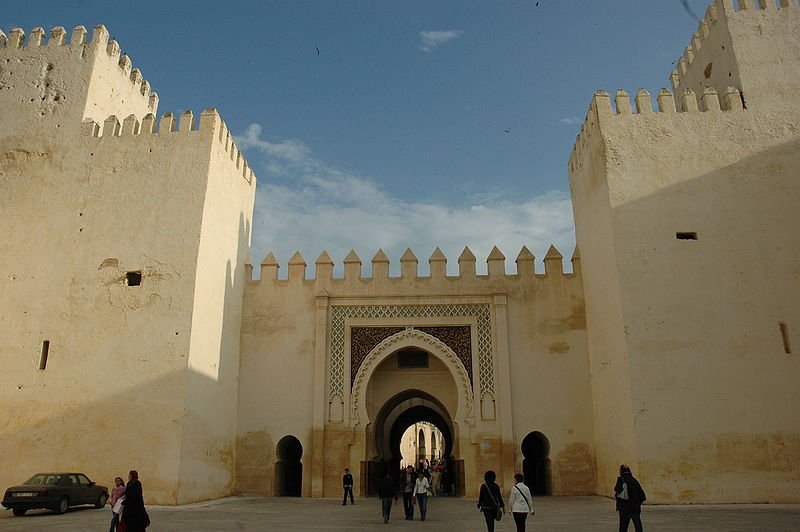 Gate of Bab el Seba, Fez
Gate of Bab el Seba, Fez http://commons.wikimedia.org/wiki/File:Fes_-_Palau_Reial_-_Bab_El_Seba_des_N.JPG
http://commons.wikimedia.org/wiki/File:Fes_-_Palau_Reial_-_Bab_El_Seba_des_N.JPG Josep Renalias
Josep Renalias
By the 15th century, Fez had become a cosmopolitan Muslim city. While the population was predominantly Berber, there are also significant communities of north Africans, Arabs, Moriscos as well as Jews. In 1554 the city fell to the Wattasid Dynasty and became a vassal state of the Ottoman Empire before being fully annexed in 1579.
Fez served as the capital of Morocco for a number of times, the last until 1912, when Morocco became a French protectorate, and the French chose Rabat as the capital. Since then the capital has remained in Rabat even after independence.
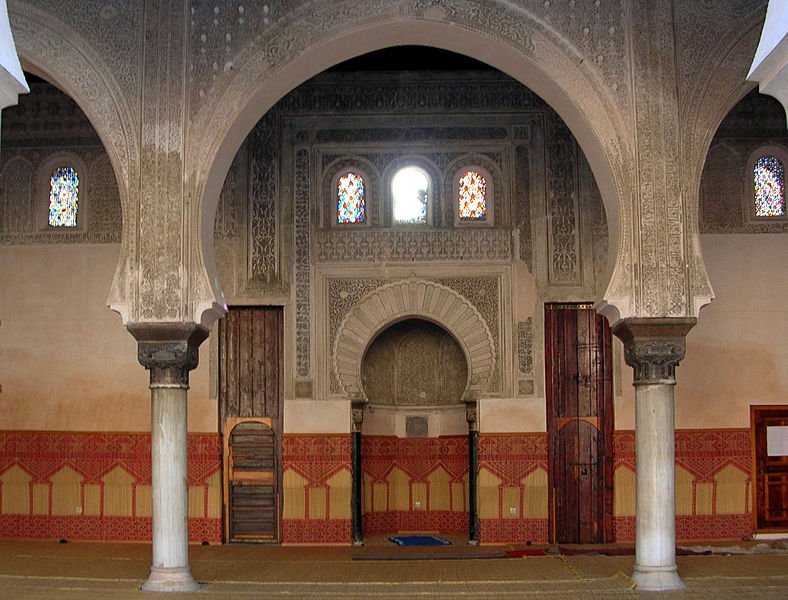 Mihrab of Bou Inania Madrasa, Fez
Mihrab of Bou Inania Madrasa, Fez http://commons.wikimedia.org/wiki/File:Bou_Inania_Madrasa.jpg
http://commons.wikimedia.org/wiki/File:Bou_Inania_Madrasa.jpg Bernard Gagnon
Bernard Gagnon
Fez is perhaps best known for producing the tarboosh, also called fez, after the city itself. This is a red truncated cone hat which was produced only in Fez until the 19th century.
Visiting Fez
You can fly to the Fes-Saiss Airport on Royal Air Maroc from London Gatwick and Paris Orly, or on Ryannair from London Stansted. Trains are also available from Casablanca (3 hours 20 min), Marrakesh (8 hours 15 min) and Tangier (4 hours 30 min).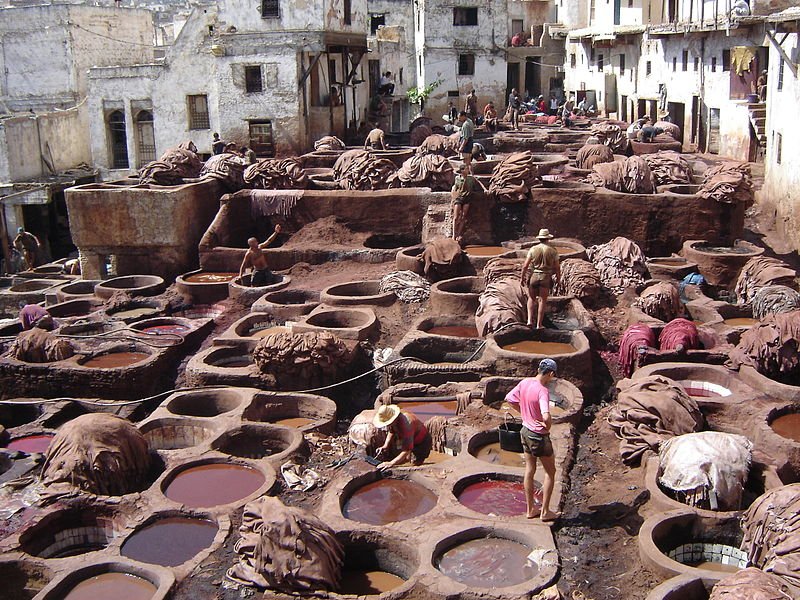 Fez Tannery
Fez Tannery http://commons.wikimedia.org/wiki/File:Fes_tannery_2.JPG
http://commons.wikimedia.org/wiki/File:Fes_tannery_2.JPG Patrick Morin
Patrick Morin
Sights & Attractions in Fez el-Bali
The Medina of Fez is a World Heritage Site of Morocco.- Andalusian Mosque
Mosque said to have been founded by Mariam el-Fihri, a Muslim woman. - Andalusian Quarter
A quiet residential quarter with a number if sights including the El-Sahrij Madrasa and the Mausoleum of Sidi Bou Ghaleb. - Bab Boujeloud
Massive entrance gate into the Fes el-Bali. - Bab el-Ftouh
Also called the Victory Gate, this is the gateway into the Andalusian Quarter. - Bou Inania Madrasa
The largest and grandest madrasa, or Muslim school, built in the 14th century by Sultan Abou Inan. - Chouara
The Fez tannery, a popular tourist attraction despite the strong smell pervading the air. - Dar el-Magana
The House of the Clock was built in 1357. Its mean feature is a water clock. - El-Attarine Madrasa
Literally the Madrasah of the Spice Sellers, this is a medieval Muslim school with fine Moorish architecture. - El-Cherratine Madrasa
Muslim school built by Moulay Rachid in 1670. - Fondouk el-Nejjarine
One of the most renowned buildings in Fez built in the 18th century, today it houes the Museum of Wood. - Karaouiyine Mosque
Dating back to AD 859, this is one of the oldest and most renowned mosques in the Muslim world and the oldest functioning university. - Merinid Tombs
Ruins of the Merinid palace and necropolis dating to the 16th century. - Musé Dar el-Batha
Museum housed in the 19th century Palace of Dar el-Batha, today showcasing a treasure trove of artifacts and surrounded by a fabulous Andalusian garden. - Musée des Armes
The Museum of Arms housed in the former Borj Nord citadel which was built in 1582. Today it showcases a collection of weapons from pre-history to early 20th century. - Place el-Seffarine
The square at the heart of the brass-ware and silverware neighborhood of Fez, with a lovely fountain in the middle and surrounded by metal workshops. - Rue Talaa Kebira
Canopy-sheltered thoroughfare lined with small shops. - Souks of Fez
The traditional market place or bazaar of Fez. Traders are grouped according to the things they sold. - Zaouia of Moulay Idriss II
The most venerated shrine in Morocco with the tomb of the second Idrissid ruler.
Sights & Attractions in Fès el-Jedid
- Danan Synagogue
The 17th century synagogue of the Jews from Andalusia in the Mellah. - Dar el-Makhzen
Palace complex of the sultan covering some 80 hectares and surrounded by high walls. - Grande Rue de Fès el-Jedid
The congested main street through Fès el-Jedid, lined on both sides with shops. - Kasbah Cherarda
Citadel built by Moulay Rachid in the 17th century. It is also called the Thursday Fort (Kasbah el-Khmis) because a Thursday market (El-Khmis Souk) is held on its northern and eastern walls. - Méchouars
Walled parade grounds used for military processions. There are three in Fez: Grand Méchouar, Vieux Méchouar (also called Méchouar de Bab Dekaken) and Petit Méchouar. - Mellah
The Jewish quarter of Fez, named after the Arabic word for salt. This is said to be the first Jewish quarter in Morocco. - Moulay Abdallah Quarter
A neighborhood to the west of the palace walls comprising a network of narrow alleys. Among the sights here include the 13th century Grand Mosque and the mid-18th century Mosque of Moulay Abdallah. - Muslim Quarters
The main neighborhood of Fè el-Jedid, enclosed by the palace walls of Dar el-Makhzen. The neighbourhood is entered through a number of monumental gates, among them Bab Dekaken and Bab el-Semarine. - Rue Boukhessissat
Street separating the Mellah from the Dar el-Makhzen. Once an aristocratic area, it has houses that reflect the wealth of its occupants. - Rue des Mérinides
Street in Mellah lined with Jewish goldsmiths and jewelry shops.
 Latest updates on Penang Travel Tips
Latest updates on Penang Travel Tips
About this website

Dear visitor, thank you so much for reading this page. My name is Timothy Tye and my hobby is to find out about places, write about them and share the information with you on this website. I have been writing this site since 5 January 2003. Originally (from 2003 until 2009, the site was called AsiaExplorers. I changed the name to Penang Travel Tips in 2009, even though I describe more than just Penang but everywhere I go (I often need to tell people that "Penang Travel Tips" is not just information about Penang, but information written in Penang), especially places in Malaysia and Singapore, and in all the years since 2003, I have described over 20,000 places.
While I try my best to provide you information as accurate as I can get it to be, I do apologize for any errors and for outdated information which I am unaware. Nevertheless, I hope that what I have described here will be useful to you.
To get to know me better, do follow me on Facebook!
Copyright © 2003-2025 Timothy Tye. All Rights Reserved.

 Go Back
Go Back